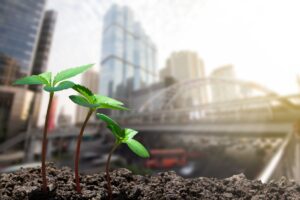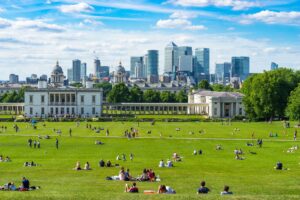Air Quality News editor Chloe Coules discovers the natural ability of plants to tackle air pollution and investigates how local authorities can incorporate green spaces in their clean air strategies.
Despite many local authorities incorporating green space in their plans to tackle air pollution, there is still much debate around how effective plants can be in improving the quality of our air and whether they are a valid strategy.
Recent research has begun to shed light on the mechanisms through which plants can clean the air.
‘The interactions between green spaces and air quality are fascinating and increasingly understood. Green space can effectively change the quality and composition of the air that city dwellers inhale,’ says Arnt Diener, advisor to the World Health Organization and environmental epidemiologist at Heinrich-Heine University.
His research review has identified three underlying mechanisms that explain how green space can reduce air pollution exposure:
- Deposition: Experiments have shown that living plants can facilitate the deposition of a much higher quantity of pollutants than similarly shaped artificial structures.
- Dispersion: Strategically placed plants can lower local pollutant concentrations by acting as a shield.
- Modification: Several gaseous and particulate pollutants in the air are transformed by plants, either on their surface or within their structures. Plants can also improve or worsen pre-conditions for air pollution formation, such as air temperature or humidity.
However, despite growing understanding of how plants can clean the air, there is still controversy around how effective they are at it.

How effective are plants at tackling pollution?
‘The air quality improvement by a green space is not easily estimated in contrast to emission reductions, such as by removing a known number of pollutant sources,’ Arnt Diener tells Air Quality News.
The Air Quality Expert Group (AQEG), which provides independent scientific advice on air quality to Defra, concluded in their report on the Effects of Vegetation on Urban Air Pollution that overall, current evidence suggests that trees and vegetation are not a solution to air quality problems at a city scale.
However, they found strong evidence that healthy, well-chosen and well-placed urban trees can provide a large range of economic and social benefits, including a relatively small but beneficial impact on urban air quality.
Their report suggests that trees can help to mitigate the effects of traffic, industry and power production by filtering particulate matter (PM) and absorbing gaseous pollutants, such as ozone, sulphur dioxide and nitrogen oxides, although they are not very efficient sinks for nitrogen dioxide.
Despite questions around the effectiveness of plant-based interventions on a city-wide scale, there has been compelling evidence about their benefits at a local level.
‘When placed correctly, bushes between a road and pedestrian path can distance and shield us (dispersion) from some of the pollution arising from exhaust fumes and road dust. Experiments showed that introducing vegetation structures downwind of a road can cut nearby pollutant concentrations in half,’ says Arnt Diener.
Prashant Kumar, Founding Director at the Global Centre for Clean Air Research (GCARE) and Chair in Air Quality & Health, Department of Civil & Environmental Engineering at the University of Surrey, also told Air Quality News that his research has recorded reductions in certain pollutants of up to 55 or 60% in several studies using vegetation to tackle air pollution.
However, controlling emissions at the source is much easier than removing pollutants once they are diluted into the atmosphere, according to the AQEG.
Recent modelling of the Greater London Area’s canopy suggests that increasing urban tree cover from 20 to 30% would only remove an additional 1% of PM from the air.
Despite this, Arnt Diener explains that even these small changes can be substantial: ‘On a regional or national scale, green spaces have been shown to reduce pollution concentrations by several per cent in model calculations. In awareness of underlying model assumptions and simplifications, such estimates suggest that green spaces may reduce air pollution by magnitudes comparable to emission reductions in certain economic sectors.’
Unlike other solutions, increasing green space also has a wider range of benefits, including increasing biodiversity, improving aesthetics, and providing ecosystem services like flood management.
Plants do also come with their own drawbacks however, including emitting air pollution precursor substances and pollen and requiring maintenance and watering.
Some plants produce high levels of biogenic volatile organic compounds (BVOCs), which can be turned into the secondary pollutant ozone when mixed with the NOx coming from traffic, warns Prashant Kumar.
‘If you have thousands of trees across the city, the BVOCs might not be affecting you directly, but they will be a major contribution to ozone formation, which is the bigger problem, Ozone is a gas which is oxidising, so it can react with the materials in the buildings or the steel and corrode it.’
Badly located green infrastructure can also make air pollution levels worse. ‘An ill-placed green space can concentrate air pollution unintendedly or block airflows that help to dilute pollutants or facilitate the exchange with other air layers,’ says Arnt Diener.

How can planners maximise their benefits?
To maximise the effectiveness of green space, Prashant Kumar advises:
- Avoiding plants that are high in pollen or BVOCs
- Choosing low maintenance plants that do not need lots of water or grow too fast
- Selecting plants with smaller, complex leaves, as they have a larger surface area for pollution to deposit on
According to the AQEG, the effect of trees on air quality can be dependent on a range of factors that local authorities and designers must consider, including street design, number and location of trees, species and canopy density, time of year and wind direction relative to the street.
They argue that planting is most effective in focused ‘hot spots’, such as schools and busy road intersections.
However, an important limitation is that the most polluted areas of cities are often those with very limited space for planting, greatly reducing the potential of mitigation using these methods.
Tech solutions are being developed to address this issue, such as Green City Solutions’ CityTree.
The CityTree enhances the natural ability of moss to eat pollution particles by using artificial wind streams.
‘Moss is an ancient plant and one of the first on our planet, and it learned to absorb everything it needs for growth from the air because it does not have roots, meaning that nutrients and water have to be absorbed over the whole surface,’ explains Peter Sänger, Co-founder and CEO of Green City Solutions.
‘On the particle level, we see absorption rates from 30 to 98% depending on the particle size – the bigger they are the easier it is to be attracted because the moss surface is kind of a carpet, so it is a dense surface where the particles are passing by or getting accumulated within and the filter layer is able to digest these particles. This means the effect is long lasting and durable and it takes between 26 and 30 days. The mosses eat up these pollution particles and then they are free before attracting new ones.’
He explains that biotech solutions can help make nature-based solutions to air pollution viable in urban environments: ‘We see that very often you don’t have the space or the right situation for planting a tree or a bush or allowing green space because space is limited and its highly valued, and that is why it is often very useful to use CityTrees or biotech solutions in combination with other greening, and that is highly dependent on the need the city has and the situation on site.’
The one thing that everyone can agree on is the need to take a holistic approach when using plants to tackle air pollution.
‘There cannot be a blueprint solution for designing a green space intervention for air quality. How green spaces interact with air pollution depends on their respective properties and on locational factors like the climate or wind regimes. Urban planners can thus combine these factors to prioritise green space interventions within a given area and to guide their design and management,’ says Arnt Diener.
‘If you want to exploit all these benefits to their best potential then you have to think more holistically about what kind of benefit they can bring. You don’t want to be putting green infrastructure all over the place thinking it will solve the problem,’ agrees Prashant Kumar.
It is clear that there is no right way to use green space to tackle air pollution, but by taking a holistic approach and considering a range of factors, local authorities can make substantial air quality improvements through something as simple as planting.
Case study: Planting to tackle pollution in Bicester
Cherwell District Council have recently begun an environmental planting scheme in Bicester as part of a wider programme of works to improve air quality and create healthier communities.
In order to maximise the benefits of the scheme, the Council chose to complement the benefits of new green space with improved active travel networks.
‘While the new landscaping will help to naturally absorb some harmful emissions, the area is designed to complement a new walking and cycling network, helping residents to take fewer trips in the car and further combat air pollution,’ explains Rosie Rowe, Cherwell District Council Head of Healthy Place Shaping.
She concludes: ‘Environmental planting on its own will not be enough to combat air pollution, but used in the right way, it can be an important, cost-effective part of the puzzle, while having wider benefits to the general wellbeing of residents. I would urge other councils to consider this approach, remembering that even a relatively small space can make a real difference.’
This article originally appeared in the April issue of Air Quality News magazine – read it in full here.












